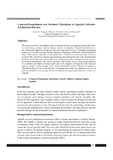| dc.description.abstract | This paper examines the adoption of corporal punishment in managing student discipline in pre-primary, primary and secondary schools in Uganda. Corporal punishment as the intentional infliction of physical pain has long been used as a method of changing behaviour. It includes caning, hitting, shaking or slapping a child either with a hand or an object. This article is based on review of literature. It discusses cultural beliefs, teachers’ personal life experiences, family programming (internalization) and wider fundamental problems in the education system like poor training of teachers as arguments for the use of corporal punishment. The article concludes that despite its use, corporal punishment is a violation of children’s human rights due to its negative consequences like physical injuries, death, school dropout, fear and psychological torture. Particular emphasis should therefore be put on formulation of appropriate policy to emphasize the use of positive discipline as a strategy for the elimination of corporal punishment in schools in Uganda. | en_US |

